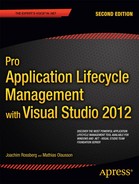Introduction
You can have the best coders in the world working in your teams, but if your project management isn’t up to scratch, your project is almost certain to be delayed, to come in over budget, and in some cases, to fail entirely. By taking precise control of your application development process, you can make changes, both large and small, throughout your project’s life cycle that will lead to better-quality, finished products that are consistently delivered on time and within budget.
Application lifecycle management (ALM) is an area of rapidly growing interest within the development community. Because its techniques allow you to deal with the process of developing applications across many areas of responsibility and across many different disciplines, its effects on your project can be wide-ranging and pronounced. It is a project management tool that has practical implications for the whole team—from architects to designers, from developers to testers.
Who This Book Is For
This book is for anyone interested in improving the development efforts in their organizations. It doesn’t matter if you are a manager, developer, tester, Scrum Master, or anything else. You can all benefit from what you will learn here. The Application Lifecycle Management process includes anyone involved in the lifecycle of an application, and Team Foundation Server 2012 and Visual Studio 2012 have something for each and every one of you. Maybe the most important lesson is that you are all working on the same team, and you are all responsible for the outcome of your development process. This realization cannot come from a tool like Team Foundation Server or Visual Studio. It is something that you need to figure out all by yourself.
How This Book Is Structured
This book is split into seven parts that will show you how you can use Visual Studio and Team Foundation Server (TFS) 2012 to implement an Application Lifecycle Management (ALM) process in your organization.
Part I explains what Application Lifecycle Management is and what problems it aims to solve. We also cover different project management processes and frameworks so that you can select the most appropriate for your organization.
Part II focuses on agile project management and how Visual Studio and Team Foundation Server 2012 can help by supporting an agile project management approach.
Part III discusses the architecture features of Visual Studio and Team Foundation Server 2012. There are several tools available that can help developers and architects in their daily work.
Part IV covers the developer tools of Visual Studio and TFS 2012. Here you see how these tools integrate with an overall ALM process that enables you to gain better control of development efforts.
Part V shows the testing features of Visual Studio and TFS 2012. It is intended for developers and testers alike.
Part VI describes how to create an effective build and release process.
Part VII focuses on Team foundation Server and covers its architecture and its extensibility, and not only on the Windows platform.
Contacting the Authors
Should you have any questions or comments—or spot a mistake you think we should know about—you can contact the authors at [email protected] or [email protected].
